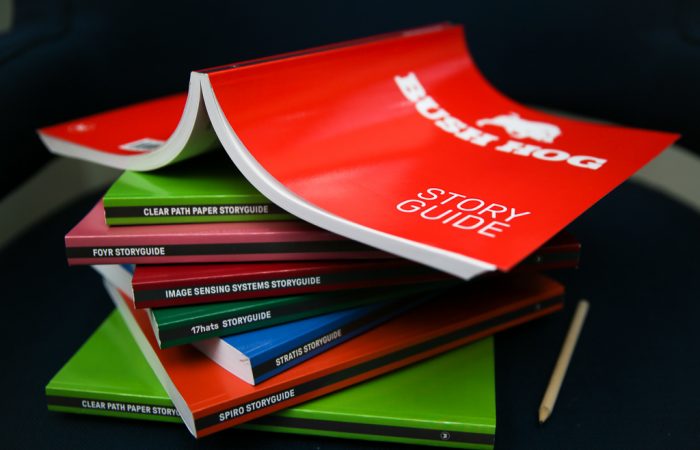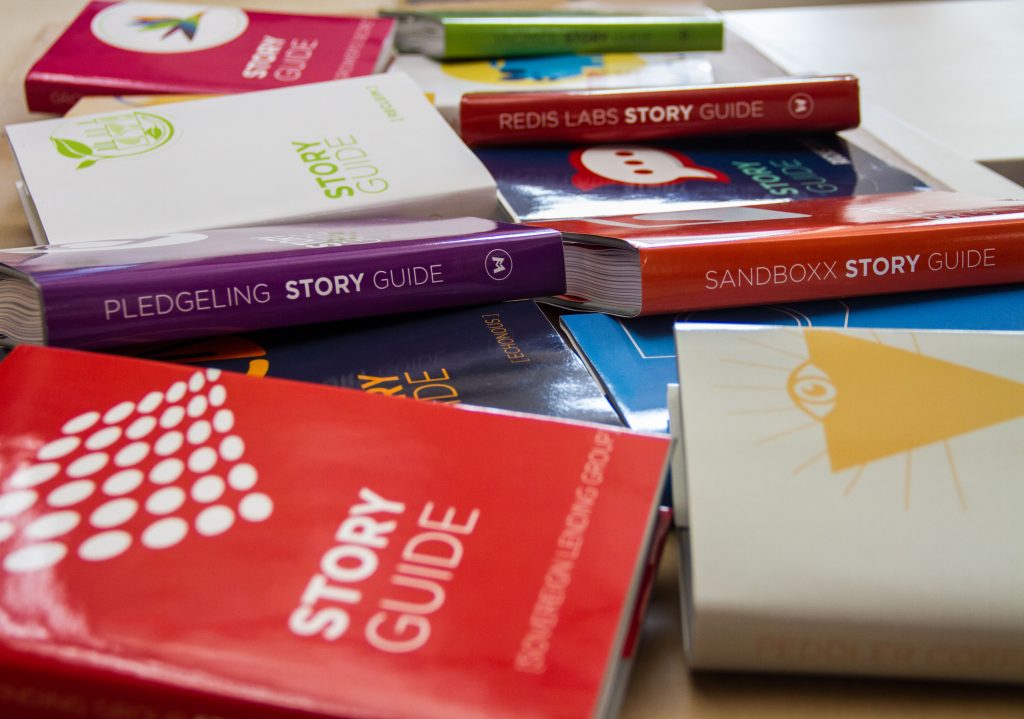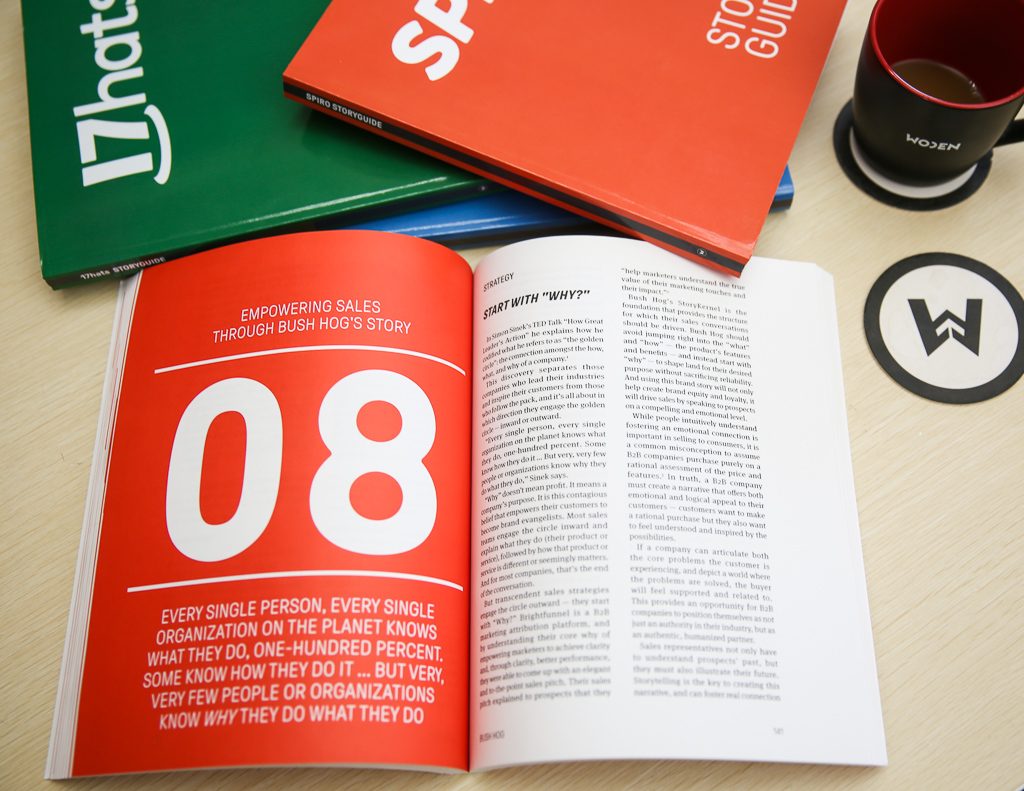
The New StoryGuide™
How Client Feedback Reinvented Woden’s Signature Offering
By Ed Lynes
Woden is an agency that does not employ a single person with a lick of agency experience. Clients appreciate working with us because we’ve sat on their side of the table, and experienced their challenges. Dan and I started Woden because we remember the impossibility of crafting clear, compelling messaging for our own companies—and the frustrations of having an otherwise excellent business that struggles because audiences won’t pay attention.
“Concentrate on that storytelling part, on the convincing people. Because if you can’t do that, it doesn’t matter how good the product is. It doesn’t matter how good the idea was for the market, or what happens in the external factors if you don’t have the people believing.”
– Stewart Butterfield, Slack
Since we opened our doors in 2014, Woden’s been animated by a single, core belief: To thrive, organizations require a clear articulation of their purpose—and must align all they do behind that story. Our foundational offering, the StoryKernel™, was developed to address that. The StoryKernel process helps a brand codify its most essential element, the moral of its story, and communicates that through a customer-focused strategic narrative. It’s a product clients love, and that our Wodenworkers take delight in crafting.
For several years, the second part of our mission—alignment for brands—eluded us. And ultimately, what good is a compelling brand story if it’s never implemented?
The StoryGuide™ is an offering created to align companies behind their story. It was unwieldy. For years, however, clients have struggled to implement it. And accordingly, our purpose eluded us. We’re thrilled to announce and share a complete recreation of the StoryGuide, so Woden can finally begin to achieve the purpose we committed to years ago. This is the story of how we tore apart our most significant product and rebuilt it in pursuit of achieving the outcomes our clients needed.
But first, we failed. I failed. A lot.
If You Fail At First—Fail, Fail, Fail Again (x61)
The first-ever StoryGuide went to print on December 31, 2015. That initial client, Ryver, is a team communication platform that was seeking differentiation from Slack. Their CEO Pat Sullivan placed his trust in what was a completely unproven firm, Woden, to help. When Pat purchased the first StoryGuide, it was nothing more than a concept of what we thought would be helpful to implement his StoryKernel. Dan, original Wodenworker Rob DePerisa and I spent the following months pulling double-duty: designing the product, and actually executing the client deliverables alongside.
We had poured ourselves into the product, strategically and creatively, and were so proud when the printed copies finally arrived. We waited, and waited, while Pat and his team digested the work. Their response? “This is cool—but what do we actually do with it?” An anticlimactic response for hundreds of hours of work on our part.
On some level, that made sense. I’m not aware of many offerings that resemble the StoryKernel, and I’ve never encountered anything that even remotely looks like a StoryGuide. Each client’s guide is a literal book, divided into chapters around key areas of the business, in which Woden articulates the ways the story ought to be implemented, shares best practices, and provides specific copy, talking points, or other resources to support the client.
The original StoryGuide was almost entirely focused on digital marketing. Ryver’s was 202 pages when all was said and done. As we engaged more and more clients, we recognized that organizational alignment behind story meant going far beyond marketing: as famed venture capitalist Ben Horowitz has observed, “story is the strategy,” which means it must be implemented in areas ranging from customer experience to culture, and from sales to product. We aggressively expanded the breadth of the StoryGuide, which only deepened our customers’ core challenge: the product was increasingly unwieldy.
With each passing engagement, we heard variations on the same theme: the StoryKernel was a wonderful process, and the StoryGuide was a cool concept, but ultimately impractical. So, we did what a lot of companies did: continued to invest in features and benefits.
By the time we delivered our sixty-first StoryGuide, to opioid treatment centers SaVida Health, the document had ballooned to 354 pages. Woden’s purpose resonated with our customers, and we continued to earn referrals—we were “good enough,” and there aren’t any other firms available purely focused on strategic storytelling and its implementation. But as a firm that preaches the power of living and breathing story in all aspects of an organization, being “good enough” felt like “not good at all.”
The team continued to refine the StoryKernel process, and delivered increasingly impactful, succinct brand stories. We added an on-site facilitation, the StorySeminar™, described by Bush Hog head of sales Kerry Meacham as “the best session of that kind I’ve ever attended.” But for every success in the first few months of our engagements, in what should have been the pinnacle moment, the delivery of the StoryGuide continued to fall flat.
It’s Our Clients Who Know Us Best

When the StoryKernel was a relatively new product, Woden was engaged by Swift Financial. Jay Lee, Swift’s CMO, invested hours of his time in helping us refine their StoryKernel. Jay’s unique perspectives did more than ensure Swift’s success—his guidance crystalized the structure and methodology for how a StoryKernel works. Prior StoryKernels had the right approach, but it was Jay who forced us to refine our methodology and give each StoryKernel a powerful, emotional arc that inspired audiences to action. Every client since Swift has benefitted from stronger, clearer StoryKernels, thanks to what we learned from Jay.
When you’re a founding partner in a company, its products and services are like your own children. Each reflects a piece of who you are, and it’s difficult to interpret any critiques of them in a way that’s not personal or a reflection of your own abilities.
But, for the StoryGuide to succeed, Woden needed to hear the hard truths our clients were telling us, and embrace them as we had the feedback on our early StoryKernels, uncomfortable as that may be. Our clients not only understood the challenge Woden solved, but they believed in us as a team. They trusted us. We had to trust them back.
The client feedback wasn’t all negative, of course. Sandboxx founder Sam Meek remarked that his StoryGuide “felt like a masterclass in Sandboxx branding,” and that every company should undergo this exercise. But, for every Sam, there were three clients like Phil Ressler (CEO of IoT firm Sixgill), who told us he couldn’t even make it through the entire guide.
Bob Burch invested in StoryGuides for two of his companies, UgMO and BERT, but in both cases, wondered if we could “just deliver a shorter version” of the StoryGuide. Cyber security firm ReFirm Labs deployed the content from the StoryGuide almost word for word across their organization, and Shane Hassett of 3D printing network Wazp called his “inspiring.”
In more mixed evaluations, we heard from EspriGas CEO Mike Walsh and Redis Labs CMO Manish Gupta that both felt there were good recommendations, but they were almost impossible to pick out and operationalize from the StoryGuide. Other companies, like Intex Millwork and Melvin Brewing diligently implemented theirs, but found it time-consuming. Pledgeling CEO James Citron found the document so overwhelming as to be useless.
The more clients we spoke to, a common theme emerged: the StoryGuide had great content. It was just near impossible to identify and operationalize.
Purpose-Driven Product Design

The StoryGuide was designed to help companies “align all they do behind [their StoryKernel].” Achieving that purpose meant taking what we’d heard and going back to the drawing board. The entire Woden team spent days holed up in our office, mapping out each element of the existing StoryGuide, assessing which parts were vital, and which could be removed. Through stripping the document down its most essential elements, we identified additional areas of implementation where clients needed support. This outline, a definitive list of all the places story impacts an organization, became the roadmap for our new approach.
While the outline was helpful, it didn’t address the usability and quality issue. Long-tenured Wodenworker Hannah Landers observed, “I just want to do work I’m universally proud to sign my name to, and send to the client.” The team debated a number of potential formats to best deliver content and transform organizations, without actually executing that work in an ongoing, retainer-style relationship (which is contrary to our belief that true change must come from within our clients).
With no other competitive products to evaluate, we ideated purely through client feedback and self-assessment. The StoryGuide was reimagined not as a “guide” (although the name remained), but as a blueprint—a workbook-style instruction manual that would make implementing the brand story collaborative for the client’s team, easy to organize, and a pleasure to digest.
Manny Ataebi, Chief Marketing Officer at email generation platform stensul, was particularly helpful in this process. He provided our team with pages of notes on his StoryGuide experience, and like Jay Lee before him, invested his own time to directly coach and guide us on how StoryGuides were being used in the field—and the ways the product should change to realize its potential.
With the entire scope of creating a story-driven organization mapped out, and a form factor that our clients agreed would make the StoryGuide the product they needed it to be, manager Kelly Sarabyn led the team through what can best be described as an editorial hackathon. For weeks on end, the team wrote, edited, rewrote, researched, edited, and rewrote some more. Like that first StoryGuide, this was done alongside delivering existing client commitments.
The outcome was a framework for brand storytelling, organized into 13 distinct areas. The new StoryGuide trimmed its overall size down remarkably—back to just over 200 pages. The new format prioritized digestibility and actions, replacing pages of prose with easy-to-follow strategies, implementation guidelines ready for teams to execute, and visual elements that made finding and consuming content intuitive. While still remarkable in its breadth, the new StoryGuide provided tabbed sections for easy reference, and page design that invited engagement, markups, and commentary.
This gave clients the best of both worlds: the view of story and its impact valued by many of the founders we’d engaged, and the need for practical nuts and bolts operational leaders craved to make their organizations story-driven. Woden engagements have always been structured to reflect the types of high-growth companies we engage with—each is a 10-to-12 week sprint that keeps the client focused on the day-to-day of their business while we move their brand forward. The StoryKernel, StorySeminar, and StoryGuide are products, not services, and while bespoke in outcome, they follow a consistent framework client-to-client.

The process of rebuilding one of our core offerings has done more than just improve client outcomes. Our team remains in “constant beta” mode—Wodenworkers now see product improvement as a core function of their role, with customer feedback and self-analysis informing team discussion after each delivery. By making the creation process an “all hands on deck” activity, today’s team sees more ownership of engagements than ever, an empowerment I see positively translate to client experience each day.
Every organization needs a story that’s clear, compelling, and memorable to be successful. Woden helps brands uncover their purpose, and codify it into a narrative audiences can’t help but respond to: the StoryKernel. And, now, thanks to the feedback of our clients and drive of our team, we can ensure every aspect of our clients’ business is aligned behind that message through the StoryGuide.
The moment Ryver’s StoryGuide arrived in our office was incredible. But now, the delivery of each new StoryGuide gives me a similar rush of excitement each week. When the package arrives, I tear it open to pour over each page, marveling at how fortunate we are to earn the trust of incredible organizations to tell their story, confident they feel the same way.
Woden is committed to ensuring each StoryGuide is better than the last, because this work matters. It transforms brands, and helps them impact their own clients and teams in untold ways. The work we’re doing today is the best we’ve ever done, and is a testament to the almost 200 incredible clients who have shaped Woden up to this point. Our entire team is proud to bring this new version of the StoryGuide into the world, and looking forward to the future clients whose stories we’ll get to define. What’s your story?
Ed Lynes is a founding partner at Woden. If you want to understand more of the science behind the StoryKernel and StoryGuide, read our extensive overview on the science of brand storytelling. Want to learn about how we help brands, or provide more of the feedback we love? Ed would love to hear from you directly.

